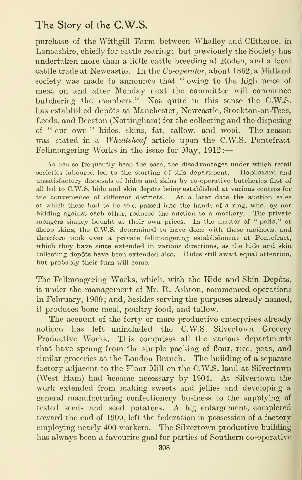Page 388 - The_story_of_the_C._W._S._The_jubilee_history_of_the_cooperative_wholesale_society,_limited._1863-1913_(IA_storyofcwsjubill00redf) (1)_Neat
P. 388
The Story of the C.W.S. —
purchase of the Withgill Farm between Whalley and CHtheroe, in
Lancashire, chiefly for cattle rearing ; but previously the Societj^ has
undertaken more than a little cattle breeding at Roden, and a local
cattle trade at Newcastle. In the Co-operator, about 1862, a Midland
society was made to announce that " 0"ning to the high price of
meat on and after Monday next the committee will commence
butchering the members." Not quite in this sense the C.W.S.
has established depots at Manchester, Newcastle, Stockton-on-Tees,
Leeds, and Beeston (Nottingham) for the collecting and the disposmg
" " hides, skins, tallow, and wool. The reason
of our owTi fat,
was stated in a Wheatsheaf article upon the C.W.S. Pontefract
Fellmongering Works in the issue for May, 1912:
As has so frequently been the case, the disadvantages iinder which retail
societies laboured led to the starting of this department. Haphazard and
unsatisfactory disposals of hides and skins by co-operative butcheries first of
all led to C.W.S. hide and skin depots being established at various centres for
the convenience of diPEerent districts. At a later date the auction sales
at which these had to be sold passed into the hands of a ring, who, by not
bidding against each other, reduced the ai:ction to a mockery. The private
mongers simply bought at their own prices. In the matter of " pelts," or
sheep skins, the C.W.S. determined to have done with these methods, and
therefore took over a private fellmongering establishment at Pontefract,
which they have since extended in various directions, as the hide and skin
collecting depots have been extended also. Hides still await equal attention,
but probably their turn will come.
The Fellmongering Works, which, with the EQde and Skin Depots,
is under the management of Mr. R. Ashton, commenced operations
in February, 1909; and, besides serving the purposes already named,
it produces bone meal, poultry food, and tallow.
The account of the fort}" or more productive enterprises already
noticed has left unincluded the C.W.S. Silvertown Grocery
Productive Works. This comprises all the various departments
that have sprung from the simple packing of flour, rice, peas, and
similar groceries at the London Branch. The building of a separate
factory adjacent to the Flour Mill on the C.W.S. land at SilvertowTi
(West Ham) had become necessary by 1904. At SilvertowTi the
work extended from making sweets and jeUies and developing a
general manufacturing confectionery business to the supplying of
tested seeds and seed potatoes. A big enlargement, completed
toward the end of 1909, left the federation in possession of a factory
employing nearly 400 workers. The Silvertown productive building
has always been a favourite goal for parties of Southern co-operative
308

